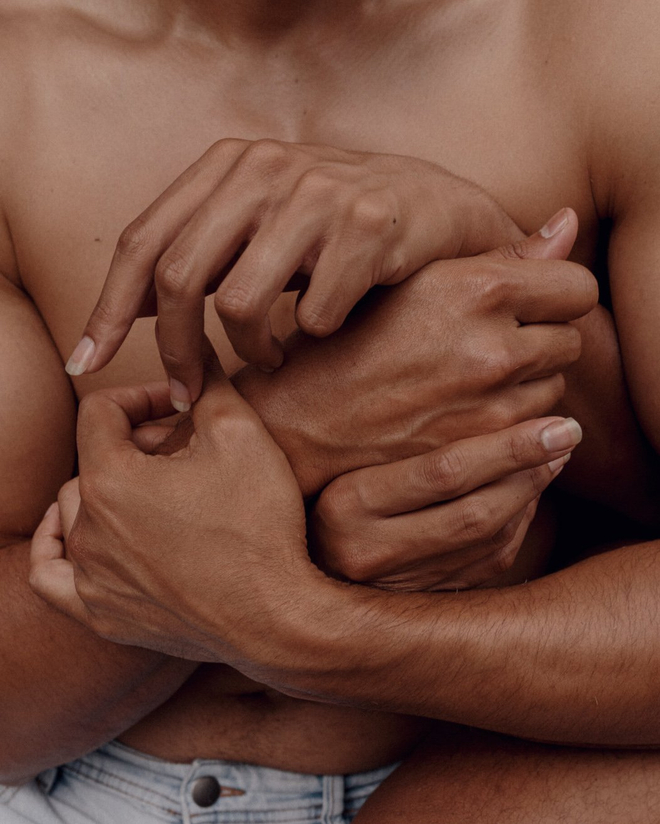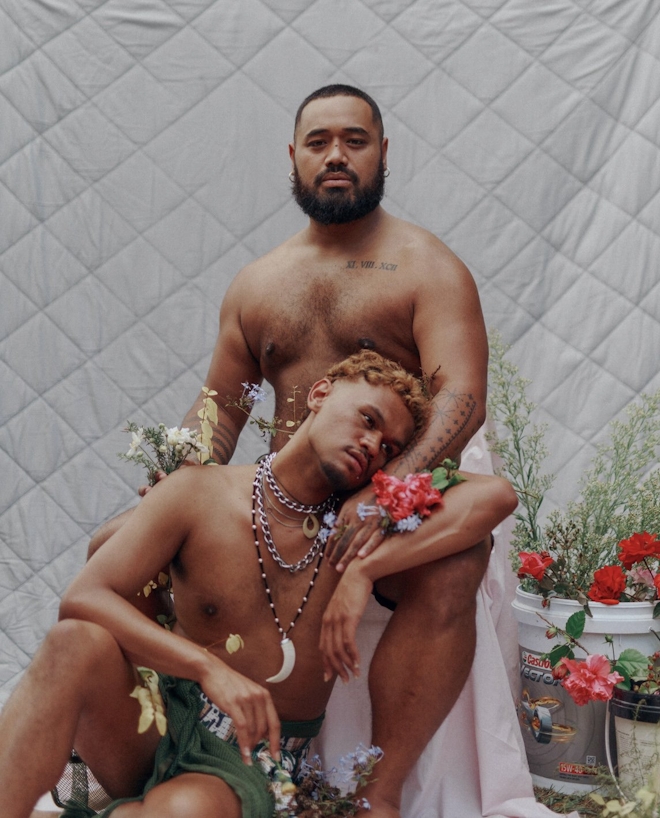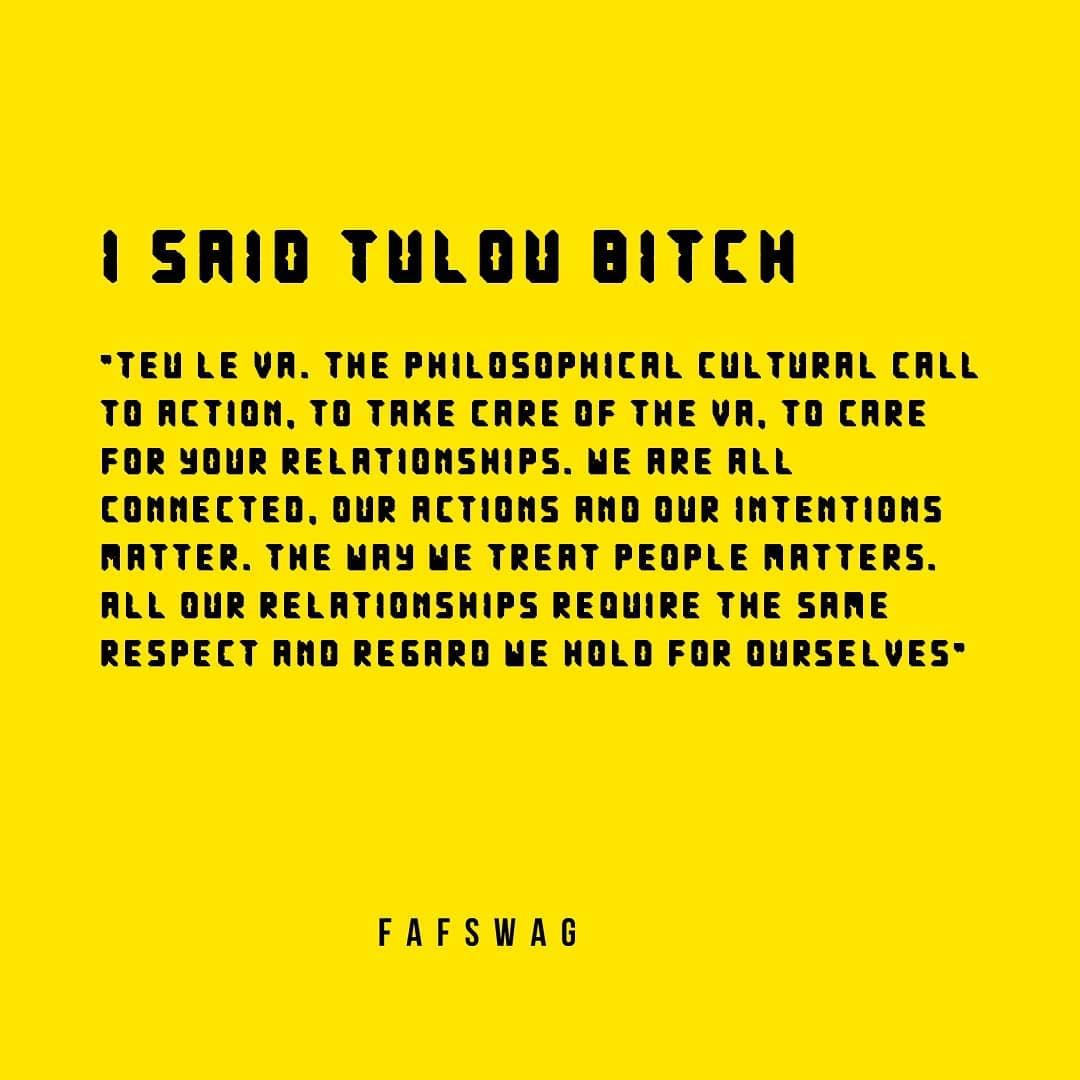Originally commissioned as a project for one of the Biennale’s many public spaces, the advent of Covid-19 resulted in the events organisers asking the artists to remake their work for the online space.
If FAFSWAG’s original intention was “a series of public actions, engaging with people in ways that have come to define our collective practice as a social and community-building practice,” the presumed ease of pivoting the project from gallery to online swiftly raised concerns. Writing online, FAFSWAG founder Tanu Gago noted data-sovereignty, safe-space and intellectual property as a few of the issues that arise in this space. Nevertheless, he continues on the CODESWITCH site:
“the inability to physically facilitate space or generate audiences IRL [in real life], has dramatically excavated deep and challenging conversations about value...While FAFSWAG concerns have been identified, we’ve also had to reprioritize our approach to art making and community-building. So here we are.”
The collectives first strategy to claim agency in the online space is to name all of the sites pages and navigation not in English but languages of the Pacific. Once inside the FAFSWAG website it is noticeably a hub not just for all of the creative ventures involved in the CODESWITCH project, but also their community-building activities. Social posts and symposium panel discussions sit alongside poetry, photography and moving image. Of particular note is the Talanoa page, which shares conversations on collaboration, working in and outside the collective, discussions around particular pieces, the complexities of working across issues of gender, identity and so on. These interviews provide insight into the guiding values and principles of the collective.

On the Faiva page, FAFSWAG present a selection of moving image works. Created in response to the criminalisation of homosexuality in the Cook Islands, Protection (2020) by Nahora Ioane and Tanu Gago, is nothing short of mesmerising. The blurred image of a lone figure comes abruptly into focus, looking directly at the camera, sometimes under a red scarf. The combination of modern beats accompanied by the strident cries of a haka is a purposeful interaction of contemporary motifs and ancestral knowledge, an intuitive strategy that indigenous cultures have understood and utilised for centuries. The sound holds the intensity and directness of masculine energies. Yet the self-described ‘war dance’ performed appears gentle, graceful, and strong in every sense of femininity. A harmonious balance between movement, lighting and mood, Protection is highly seductive. As it comes to a close, there is a residue of intoxication and a desire to re-immerse.
Protection (2020) Nahora Ioane and Tanu Gago
In the online world there is a loss of scale, but on CODESWITCH the work travels in new directions, igniting a new fire of conversations.
Writing on the FAFSWAG Instagram, Ioane passionately described the power of dance as an expression of cultural and political freedom:
“It’s easy to say dancing isn’t doing anything to change the situation. But my people have been dancing since the beginning of time. This dance is for me, as much as it is for my sisters. I get to use my cultural language to say no. Especially to those in our culture that think we are not worthy of rights…”
I am torn between imagining this work installed in the Biennale and the gratification of being able to engage repeatedly with it online. Stoneley (2007) provides an interesting description of the cinematic experience that can also be likened to the forum of social media. “In the cinema we are removed from the world and placed in a relaxed posture, but in close proximity to others. Both alone and surrounded, and seduced by the brilliance of the figures on the screen, we ‘slide down into {our} seats as if into a bed’, and enter into a hypnotic state of arousal that is both passive and aggressive." In the online world there is a loss of scale, but on CODESWITCH the work travels in new directions, igniting a new fire of conversations.
In Whānau Ariki (2020), a piece aimed at decolonizing the bodies of "Fat, Brown, Queer Wāhine", artists Amy Lautogo, Ria Hiroki and Elyssia Wilson Heti lean right into the "entertainment" and commercial aspects of the digital landscape, utilising motifs from the simulation arena to re-imagine the representation of these women and their bodies.
Adopting the brand of a fashion house, the screen open with the words “INFAMY APPAREL”. What follows is a game-like experience of dressing a woman; with an onscreen icon of a hand hovering over women's bodies and fashion choices.
Much of the clothing is heavily influenced by the unrealistic social standards of beauty. Yet we also see indigenous women, indigenous bodies and attire suitable and desirable for them. Likewise, the cleverly manipulated voice-overs (much like the over-zealous, computer-generated voices familiar to these simulations) encourage the mouse selections to align with practical and culturally-guided clothing selection.
Whānau Ariki uses the tools of the oppressor reclaim agency over women’s bodies. The use of the mouse challenges the viewer to analyse their own prejudice and perceptions, and we are directed to decolonize this view through the lens of a “fat brown female.” Meanwhile a “Clit Invaders” pop up ad is a humorous acknowledgement of the space in which the work operates.
The linear portrayal of masculine and feminine identities is an issue that has plagued Pasifika society in the wake of European colonisation. In a series of moving image portraits that make up the film Apparatus (2018), artist Tanu Gago “seeks to provide a counter narrative to the media portrayal of Indigeneous masculinity as fixed, binary and subordinate to dominant western notions of manhood.”
Apparatus begins with a young boy playing amongst swirling lava lava patterns hanging on the washing line. The next images are of young boys in home and work settings, depicting the mainstream narratives of masculinity in their own upbringing. The sound moves from a drone to a dance-like beat and likewise the image shifts. Studio portraits, animation and images of a Polynesian man in traditional attire flash across the screen, creating patterns and movement all at once. In one of the final scenes three young men intertwine and holding each other in a dance that depicts a yearning for support, for solidarity. Apparatus is loaded, cinematic, and dives deep into the identity challenges that indigenous men face in modern society.
Artists Hohua Ropate Kurene and Tapuaki Helu investigate Pacific masculinity in a very different way. M A T A L A is a series of photographic portraits of men and flowers that investigate the notion of manhood, and ideas of identity in relation to sexuality and intimacy. The large typeface M A T A L A is reminiscent of VOGUE magazine (perhaps a nod to the role that fashion plays in stereotypes for queer men). The word translates from Tongan to ‘bloom’ in English, symbolising the growth and nurturing of different types of intimacy when supported and cultivated by the right conditions.
These works are both vibrant and subdued, beautifully edited to showcase the richness of the model's skin. The depictions of Pacific men holding flowers, or embracing each other surrounded by flowers, reflects masculinity in ways that we might typically associate with femininity via the media. Viewers are encouraged to consider ideas of vulnerability, exposure, comfortability in oneself, or the lack thereof, for our queer indigenous community.

M A T A L A (2020) Hohua Ropate Kurene
M A T A L A (2020) is a stunning portrayal of what masculinity can look like. I am hopeful to see the project as an installation. With the continual influx of imagery on social media, it is easy for portraiture to be lost amongst the feed, yet, in the gallery, they hold their space, and in turn, one can spend time standing in the presence of these ideas and experiencing the aura they omit.
In the new world that is Covid-19, every industry faces the need for adaptation and change. More and more we are seeing society moving online—the arts sector included. This brings to the forefront issues of accessibility and engagement. Artists now face a problematic terrain, particularly in safeguarding the integrity and intention of their message, over the importance of it being seen.
As indigenous practitioners, the digital/social media realm goes against the grain of a community based practice—removing the Us from I, and encouraging participation in the individualist construct of the coloniser. Tanu Gago highlights this particular challenge for FAFSWAG on the Kōrero Paki page:
“It’s these conditions that have ultimately affected the scope and objectives of this project and have in many ways shaped the means of production and distribution; two mechanical terms uncommonly used when describing a FAFSWAG project. The language we tend to use typically mirrors our values of community, communion ritual and resistance.”
That being said, the opposing notion can be put no better than through the words of Sir Apirana Ngata, the first Māori university graduate of New Zealand:
“e tipu, e rea, mō ngā rā o tou ao. Ko ō ringa ki ngā rākau a te Pākehā hei ora mō tō tinana. Ko tō ngākau ki ngā tāonga a ō tīpuna Māori, hei tikitiki mō tō māhunga…” (“grow and branch forth for the days destined to you. Your hands to the tools of the Pākehā for the welfare of your body. Your heart to the treasures of your ancestors as adornments for your brow.”)
The dichotomy presented for FAFSWAG in this project, is the forced movement into a colonised space, an individualistic framework of social engagement through social media and other online portals; and yet the opportunity to utilise the tools of the western world to further engage more of the masses in the extremely relevant and crucial dialogue that their works convey and confront.
He kōrero whakamutunga—The FAFSWAG social media pages (Facebook and Instagram) are a wondrous example of how this platform can be used to address wide-spread, current issues. I am particularly impressed by the way FAFSWAG share excerpts of poetry/writing their artists are working on, alongside photography or behind the scenes imagery. It entices viewers to continue to engage. Recognising the multi-faceted challenges of an online portal. FAFSWAG’s CODESWITCH presents an interesting dichotomy for both artist and viewer, one that I will most definitely enjoy following.
